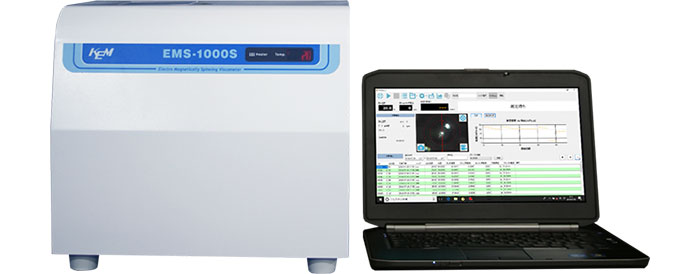
EMS viscometer is a new type innovative viscometer that changed the common sense of viscosity measurement in the world for the first time.
By applying torque to the spherical probe in the sample remotely from the outside of the sample container using the force of the magnetic field, we succeeded in completely separating the sample from the device.
We have prepared a state-of-the-art viscosity analytical technology with easy-to-use software and a spherical probe that can be selected according to sample properties, enabling application in a wide field. It is also compatible with small amount, low viscosity measurement which was difficult to measure up to now.
This product adopts part of development results obtained as the framework of JST Japan Science and Technology Agency.
(Patent application No.5093599, US 8,365,582 B2, Applicant name: The University of Tokyo)
EMS viscometer is a new type innovative viscometer that changed the common sense of viscosity measurement in the world for the first time.
By applying torque to the spherical probe in the sample remotely from the outside of the sample container using the force of the magnetic field, we succeeded in completely separating the sample from the device.
We have prepared a state-of-the-art viscosity analytical technology with easy-to-use software and a spherical probe that can be selected according to sample properties, enabling application in a wide field. It is also compatible with small amount, low viscosity measurement which was difficult to measure up to now.
This product adopts part of development results obtained as the framework of JST Japan Science and Technology Agency.
(Patent application No.5093599, US 8,365,582 B2, Applicant name: The University of Tokyo)
The standard measuring cell covers the entire viscosity range – no need to use different types of rotors.
Only 1 second is required to measure samples with a viscosity below 100mPa・s.
Approx. 1 minute is required to measure samples with a viscosity of 10,000mPa・s.
The shear rate can be varied by changing the rotational speed of motor, flow curves can be determined.
Measurements of samples which are available in very small quantities can now be performed. During measurement, the samples are not contaminated.
Samples can be used for other purposes after measurement.
Required amount of sample is 300μL in standard specification. By using an optional small volume container, it is possible to measure with a minimum sample volume of 90μL.
Measurements are performed in a disposable sample container.
No cleaning required – no cross contamination.
Ideal for samples which must be measured in a sterile environment such as proteins.
Sealed sample container. This allows to perform measurements in an inert-gas atmosphere.